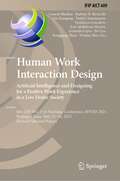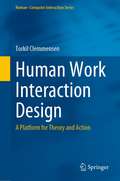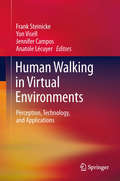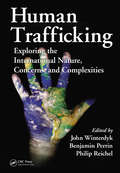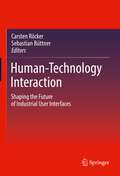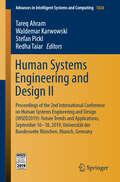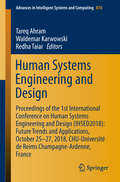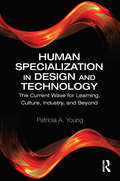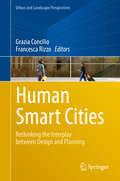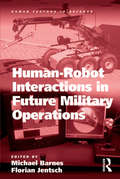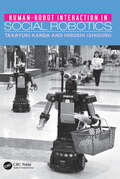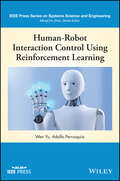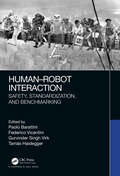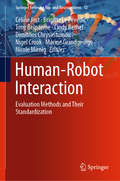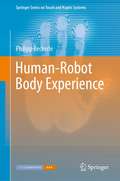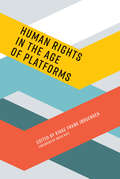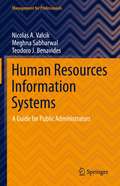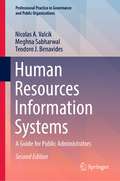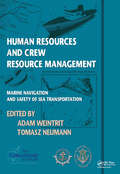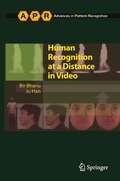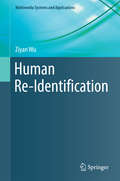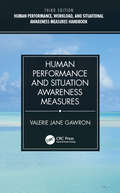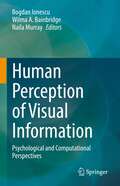- Table View
- List View
Human Work Interaction Design. Artificial Intelligence and Designing for a Positive Work Experience in a Low Desire Society: 6th IFIP WG 13.6 Working Conference, HWID 2021, Beijing, China, May 15–16, 2021, Revised Selected Papers (IFIP Advances in Information and Communication Technology #609)
by Arminda Lopes Torkil Clemmensen José Abdelnour-Nocera Frederica Gonçalves Ganesh Bhutkar Barbara R. Barricelli Qin Xiangang Fei Lyu Ronggang Zhou Wenjun HouThis book constitutes the thoroughly refereed post-conference proceedings of the 6th IFIP WG 13.6 Working Conference on Human Work Interaction Design, HWID 2021, held in Beijing, China, in May, 2021. The 10 revised and extended full papers presented were carefully selected for inclusion in this volume. The papers deal with the analysis and interaction design of a variety of complex work and life contexts found in different business and application domains. They focus on interaction design for work engagement taking usability of interactive systems to the next level by providing employees pleasurable and meaningful experiences via the tools used at work. The papers are organized the following topical sub-headings: Trends in human Work Interaction Design; Workplace & work experience Analysis for Interaction Design; and Artificial Intelligence (AI) for Human Work.
Human Work Interaction Design: A Platform for Theory and Action (Human–Computer Interaction Series)
by Torkil ClemmensenAn approach to socio-technical HCI called Human Work Interaction Design (HWID) emerged around 2005. It has grown steadily, and now is the time for sharing this research with a wider audience. In this book, the HWID approach is used to discuss socio-technical HCI theory, cases, methods, and impact. The book introduces HWID as a multi-sided platform for theorizing about socio-technical HCI work design in the digital age. It presents design cases that illustrate the design of socio-technical relations, provides specific advice for researchers, consultants, and policy makers, and reflects on the open issues related to theorizing about sociotechnical HCI. The benefits of HWID include that it meets the requirement of taking both the social and the technical into account, while focusing strongly on the relationship between the social and the technical. In addition, it is truly international and explicitly considers local cultural, organizational, and technological contexts.
Human Walking in Virtual Environments: Perception, Technology, and Applications
by Anatole Lécuyer Frank Steinicke Jennifer Campos Yon VisellThis book presents a survey of past and recent developments on human walking in virtual environments with an emphasis on human self-motion perception, the multisensory nature of experiences of walking, conceptual design approaches, current technologies, and applications. The use of Virtual Reality and movement simulation systems is becoming increasingly popular and more accessible to a wide variety of research fields and applications. While, in the past, simulation technologies have focused on developing realistic, interactive visual environments, it is becoming increasingly obvious that our everyday interactions are highly multisensory. Therefore, investigators are beginning to understand the critical importance of developing and validating locomotor interfaces that can allow for realistic, natural behaviours. The book aims to present an overview of what is currently understood about human perception and performance when moving in virtual environments and to situate it relative to the broader scientific and engineering literature on human locomotion and locomotion interfaces. The contents include scientific background and recent empirical findings related to biomechanics, self-motion perception, and physical interactions. The book also discusses conceptual approaches to multimodal sensing, display systems, and interaction for walking in real and virtual environments. Finally, it will present current and emerging applications in areas such as gait and posture rehabilitation, gaming, sports, and architectural design.
Human Trafficking: Exploring the International Nature, Concerns, and Complexities
by John Winterdyk Benjamin Perrin Philip ReichelHuman trafficking is a crime that undermines fundamental human rights and a broader sense of global order. It is an atrocity that transcends borders with some regions known as exporters of trafficking victims and others recognized as destination countries. Edited by three global experts and composed of the work of an esteemed panel of contributors,
Human-Technology Interaction: Shaping the Future of Industrial User Interfaces
by Carsten Röcker Sebastian BüttnerDigitalization and automation are leading to fundamental changes in the industrial landscape. In the German-speaking countries, this development is often summarized under the term Industry 4.0. Simultaneously, interaction technologies have made huge developments in the last decades. The use of mobile devices and touch screens is ubiquitous, augmented and virtual reality technologies have made their way into the market and new interaction concepts have become established. While new interaction technologies offer new possibilities for organizing or executing work in the context of Industry 4.0, the transformation of industrial processes also creates a need for new work practices. This book sheds light on the interplay of Industry 4.0 and new interaction technologies. It presents selected research articles on the topic of Human-Technology Interaction in the context of Industry 4.0. Researchers from various disciplines present the current state of research with regard to future interactions with production environments to develop a common vision of how to design future interactions in the industrial domain. In this context, various topics are covered: a detailed overview on assistive systems for supporting manual work is given, including technological and design aspects as well as implementation strategies. Industrial use-cases for extended reality (XR) technologies such as augmented and virtual reality (AR and VR) are presented, also covering aspects of how to author content in XR environments. The role of new work practices is examined, for example, by presenting concepts of gamification and human-machine teamwork for supporting well-being. Finally, topics of trust and technology acceptance are discussed in the context of Industry 4.0. Given this broad perspective, a vision is sketched of how to design future human-technology interactions in a way that realizes their full technical and human potential.
Human Systems Engineering and Design II: Proceedings of the 2nd International Conference on Human Systems Engineering and Design (IHSED2019): Future Trends and Applications, September 16-18, 2019, Universität der Bundeswehr München, Munich, Germany (Advances in Intelligent Systems and Computing #1026)
by Tareq Ahram Waldemar Karwowski Stefan Pickl Redha TaiarThis book focuses on novel design and systems engineering approaches, including theories and best practices, for promoting a better integration of people and engineering systems. It covers a range of hot topics related to: development of human-centered systems; interface design and human-computer interaction; usability and user experience; emergent properties of human behavior; innovative materials in manufacturing, biomechanics, and sports medicine, safety engineering and systems complexity business analytics, design and technology and many more. The book, which gathers selected papers presented at the 2nd International Conference on Human Systems Engineering and Design: Future Trends and Applications (IHSED 2019), held on September 16-18, 2019, at Universität der Bundeswehr München, Munich, Germany, provides researchers, practitioners and program managers with a snapshot of the state-of-the-art and current challenges in the field of human systems engineering and design.
Human Systems Engineering and Design: Proceedings of the 1st International Conference on Human Systems Engineering and Design (IHSED2018): Future Trends and Applications, October 25-27, 2018, CHU-Université de Reims Champagne-Ardenne, France (Advances in Intelligent Systems and Computing #876)
by Redha Taiar Waldemar Karwowski Tareq AhramThis book focuses on novel design and systems engineering approaches, including theories and best practices, for promoting a better integration of people and engineering systems. It covers a range of hot topics related to: development of activity-centered and user-centered systems; interface design and human-computer interaction; usability and user experience; cooperative, participatory and contextual models; emergent properties of human behavior; innovative materials in manufacturing, and many more. Particular emphasis is placed on applications in sports, healthcare, and medicine. The book, which gathers selected papers presented at the 1st International Conference on Human Systems Engineering and Design: Future Trends and Applications (IHSED 2018), held on October 25-27, 2018, at CHU-Université de Reims Champagne-Ardenne, France, provides researchers, practitioners and program managers with a snapshot of the state-of-the-art and current challenges in the field of human systems engineering and design.
Human Specialization in Design and Technology: The Current Wave for Learning, Culture, Industry, and Beyond
by Patricia A. YoungHuman Specialization in Design and Technology explores emerging trends in learning and training—standardization, personalization, customization, and specialization—with a unique focus on innovations specific to human needs and conditions. Analyzing evidence from current academic research as well as the popular press, this concise volume defines and examines the trajectory of instructional design and technologies toward more human-centered and specialized products, services, processes, environments, and systems. Examples from education, healthcare, business, and other sectors offer real-world demonstrations for scholars and graduate students of educational technology, instructional design, and business development. The book features insights into the future of professors, public schools, equity and access, extended technologies, open educational resources, and more, concluding with a set of concrete solutions.
Human Smart Cities
by Francesca Rizzo Grazia ConcilioWithin the most recent discussion on smart cities and the way this vision is affecting urban changes and dynamics, this book explores the interplay between planning and design both at the level of the design and planning domains' theories and practices. Urban transformation is widely recognized as a complex phenomenon, rich in uncertainty. It is the unpredictable consequence of complex interplay between urban forces (both top-down or bottom-up), urban resources (spatial, social, economic and infrastructural as well as political or cognitive) and transformation opportunities (endogenous or exogenous). The recent attention to Urban Living Lab and Smart City initiatives is disclosing a promising bridge between the micro-scale environments, with the dynamics of such forces and resources, and the urban governance mechanisms. This bridge is represented by those urban collaborative environments, where processes of smart service co-design take place through dialogic interaction with and among citizens within a situated and cultural-specific frame.
Human Security in China: A Post-Pandemic State
by Chi ZhangThis book explores the emergent concept of 'human security' within the political context of COVID-19 Chinese politics. For decades, Western nations have used 'human rights' as a rubric with which to scold Chinese leaders, betraying a fundamental unwillingness to accept diversity of governance systems. As COVID-19 has demonstrated, different governance systems yield different outcomes—the freedom of circulation, speech and movement in Western democracies yielding one, and use of surveillance, lockdowns, and private–public collaboration in China and Asian societies such as Korea and Singapore yielding another. Chinese political scientists have become fixated on the notion of 'human security,' a utilitarian concept which insists on the importance of protecting and extending human life via health care, technology, and a wide range of other systems—sometimes, in ways which contradict Western notions of human rights, even as they demonstrably achieve superior outcomes for the humans involved. Being the first English language book to explore these issues, this book aims to generate a sustained theoretical relevance in the aftermath of the crisis which is likely to have lasting effects on how people live and will be of note for political scientists, China scholars, and economists.
Human-Robot Interactions in Future Military Operations (Human Factors in Defence)
by Florian JentschSoldier-robot teams will be an important component of future battle spaces, creating a complex but potentially more survivable and effective combat force. The complexity of the battlefield of the future presents its own problems. The variety of robotic systems and the almost infinite number of possible military missions create a dilemma for researchers who wish to predict human-robot interactions (HRI) performance in future environments. Human-Robot Interactions in Future Military Operations provides an opportunity for scientists investigating military issues related to HRI to present their results cohesively within a single volume. The issues range from operators interacting with small ground robots and aerial vehicles to supervising large, near-autonomous vehicles capable of intelligent battlefield behaviors. The ability of the human to 'team' with intelligent unmanned systems in such environments is the focus of the volume. As such, chapters are written by recognized leaders within their disciplines and they discuss their research in the context of a broad-based approach. Therefore the book allows researchers from differing disciplines to be brought up to date on both theoretical and methodological issues surrounding human-robot interaction in military environments. The overall objective of this volume is to illuminate the challenges and potential solutions for military HRI through discussion of the many approaches that have been utilized in order to converge on a better understanding of this relatively complex concept. It should be noted that many of these issues will generalize to civilian applications as robotic technology matures. An important outcome is the focus on developing general human-robot teaming principles and guidelines to help both the human factors design and training community develop a better understanding of this nascent but revolutionary technology. Much of the research within the book is based on the Human Research and Engineering Directorate (HRED), U.S. Army Research Laboratory (ARL) 5-year Army Technology Objective (ATO) research program. The program addressed HRI and teaming for both aerial and ground robotic assets in conjunction with the U.S. Army Tank and Automotive Research and Development Center (TARDEC) and the Aviation and Missile Development Center (AMRDEC) The purpose of the program was to understand HRI issues in order to develop and evaluate technologies to improve HRI battlefield performance for Future Combat Systems (FCS). The work within this volume goes beyond the research results to encapsulate the ATO's findings and discuss them in a broader context in order to understand both their military and civilian implications. For this reason, scientists conducting related research have contributed additional chapters to widen the scope of the original research boundaries.
Human-Robot Interaction in Social Robotics
by Takayuki Kanda Hiroshi IshiguroHuman–Robot Interaction in Social Robotics explores important issues in designing a robot system that works with people in everyday environments. Edited by leading figures in the field of social robotics, it draws on contributions by researchers working on the Robovie project at the ATR Intelligent Robotics and Communication Laboratories, a world leader in humanoid interactive robotics. The book brings together, in one volume, technical and empirical research that was previously scattered throughout the literature. Taking a networked robot approach, the book examines how robots work in cooperation with ubiquitous sensors and people over telecommunication networks. It considers the use of social robots in daily life, grounding the work in field studies conducted at a school, train station, shopping mall, and science museum. Critical in the development of network robots, these usability studies allow researchers to discover real issues that need to be solved and to understand what kinds of services are possible. The book tackles key areas where development is needed, namely, in sensor networks for tracking humans and robots, humanoids that can work in everyday environments, and functions for interacting with people. It introduces a sensor network developed by the authors and discusses innovations in the Robovie humanoid, including several interactive behaviors and design policies. Exploring how humans interact with robots in daily life settings, this book offers valuable insight into how robots may be used in the future. The combination of engineering, empirical, and field studies provides readers with rich information to guide in developing practical interactive robots.
Human-Robot Interaction Control Using Reinforcement Learning (IEEE Press Series on Systems Science and Engineering)
by Wen Yu Adolfo PerrusquiaA comprehensive exploration of the control schemes of human-robot interactions In Human-Robot Interaction Control Using Reinforcement Learning, an expert team of authors delivers a concise overview of human-robot interaction control schemes and insightful presentations of novel, model-free and reinforcement learning controllers. The book begins with a brief introduction to state-of-the-art human-robot interaction control and reinforcement learning before moving on to describe the typical environment model. The authors also describe some of the most famous identification techniques for parameter estimation. Human-Robot Interaction Control Using Reinforcement Learning offers rigorous mathematical treatments and demonstrations that facilitate the understanding of control schemes and algorithms. It also describes stability and convergence analysis of human-robot interaction control and reinforcement learning based control. The authors also discuss advanced and cutting-edge topics, like inverse and velocity kinematics solutions, H2 neural control, and likely upcoming developments in the field of robotics. Readers will also enjoy: A thorough introduction to model-based human-robot interaction control Comprehensive explorations of model-free human-robot interaction control and human-in-the-loop control using Euler angles Practical discussions of reinforcement learning for robot position and force control, as well as continuous time reinforcement learning for robot force control In-depth examinations of robot control in worst-case uncertainty using reinforcement learning and the control of redundant robots using multi-agent reinforcement learning Perfect for senior undergraduate and graduate students, academic researchers, and industrial practitioners studying and working in the fields of robotics, learning control systems, neural networks, and computational intelligence, Human-Robot Interaction Control Using Reinforcement Learning is also an indispensable resource for students and professionals studying reinforcement learning.
Human-Robot Interaction: Safety, Standardization, and Benchmarking
by Paolo Barattini Federico Vicentini Gurvinder Singh Virk Tamas HaideggerHuman-Robot Interaction: Safety, Standardization, and Benchmarking provides a comprehensive introduction to the new scenarios emerging where humans and robots interact in various environments and applications on a daily basis. The focus is on the current status and foreseeable implications of robot safety, approaching these issues from the standardization and benchmarking perspectives. Featuring contributions from leading experts, the book presents state-of-the-art research, and includes real-world applications and use cases. It explores the key leading sectors—robotics, service robotics, and medical robotics—and elaborates on the safety approaches that are being developed for effective human-robot interaction, including physical robot-human contacts, collaboration in task execution, workspace sharing, human-aware motion planning, and exploring the landscape of relevant standards and guidelines. <P><P>Features <P><P>Presenting a comprehensive introduction to human-robot interaction in a number of domains, including industrial robotics, medical robotics, and service robotics <P><P>Focusing on robot safety standards and benchmarking <P><P>Providing insight into current developments in international standards <P><P>Featuring contributions from leading experts, actively pursuing new robot development
Human-Robot Interaction: Evaluation Methods and Their Standardization (Springer Series on Bio- and Neurosystems #12)
by Céline Jost Brigitte Le Pévédic Tony Belpaeme Cindy Bethel Dimitrios Chrysostomou Nigel Crook Marine Grandgeorge Nicole MirnigThis book offers the first comprehensive yet critical overview of methods used to evaluate interaction between humans and social robots. It reviews commonly used evaluation methods, and shows that they are not always suitable for this purpose. Using representative case studies, the book identifies good and bad practices for evaluating human-robot interactions and proposes new standardized processes as well as recommendations, carefully developed on the basis of intensive discussions between specialists in various HRI-related disciplines, e.g. psychology, ethology, ergonomics, sociology, ethnography, robotics, and computer science. The book is the result of a close, long-standing collaboration between the editors and the invited contributors, including, but not limited to, their inspiring discussions at the workshop on Evaluation Methods Standardization for Human-Robot Interaction (EMSHRI), which have been organized yearly since 2015. By highlighting and weighing good and bad practices in evaluation design for HRI, the book will stimulate the scientific community to search for better solutions, take advantages of interdisciplinary collaborations, and encourage the development of new standards to accommodate the growing presence of robots in the day-to-day and social lives of human beings.
Human-Robot Body Experience (Springer Series on Touch and Haptic Systems)
by Philipp BeckerleThis monograph presents innovative research regarding the body experience of human individuals who are using assistive robotic devices such as wearable robots or teleoperation systems. The focus is set on human-in-the-loop experiments that help to empirically evaluate how users experience devices. Moreover, these experiments allow for further examination of the underlying mechanisms of body experience through extending existing psychological paradigms, e.g., by disentangling tactile feedback from contacts. Besides reporting and discussing psychological examinations, the influence of various aspects of engineering design is investigated, e.g., different implementations of haptic interfaces or robot control. As haptics are of paramount importance in this tight type of human-robot interaction, it is explored with respect to modality as well as temporal and spatial effects. The first part of the book motivates the research topic and gives an in-depth analysis of the experimental requirements. The second and third part present experimental designs and studies of human-robot body experience regarding the upper and lower limbs as well as cognitive models to predict them. The fourth part discusses a multitude of design considerations and provides directions to guide future research on bidirectional human-machine interfaces and non-functional haptic feedback.
Human Rights Law and Regulating Freedom of Expression in New Media: Lessons from Nordic Approaches (Routledge Research in Human Rights Law)
by Mart Susi Jukka Viljanen Eiríkur Jónsson Artūrs KučsThe Nordic countries are well known globally for their high human rights standards and, at the same time, high degree of internet freedom. This edited collection reveals how the Nordic countries have succeeded in the task of protecting freedom of expression in the new media. It contains an overview of public policy choices and best practices of domestic online companies, which have the aspiration of finding global acceptance. Reviewing the topic of freedom of expression in new media within Nordic and Baltic countries, this book incorporates both general themes and interesting country-specific themes that will provide wider knowledge on the development of freedom of expression and media law in the online media era. A comprehensive analysis of regulation of online media, both at the level of legislation and application of law in courts and other authorities, are included. This book will contribute to the ongoing discussion as to whether there is a need to modify prevailing interpretation of freedom of expression. Human Rights Law and Regulating Freedom of Expression in New Media focuses on the multi-layered and complicated relationship between internet and human rights law. It contributes to the ongoing discussion regarding the protection of freedom of expression on the internet in the context of various doctrines of constitutional law, including the proliferation of constitutional adjudication. It will be of interest to researchers, academics, policymakers, and students in the fields of human rights law, internet law, political science, sociology, cultural studies, media and communications studies and technology.
Human Rights in the Age of Platforms (Information Policy)
by Rikke Frank JørgensenScholars from across law and internet and media studies examine the human rights implications of today's platform society.Today such companies as Apple, Facebook, Google, Microsoft, and Twitter play an increasingly important role in how users form and express opinions, encounter information, debate, disagree, mobilize, and maintain their privacy. What are the human rights implications of an online domain managed by privately owned platforms? According to the Guiding Principles on Business and Human Rights, adopted by the UN Human Right Council in 2011, businesses have a responsibility to respect human rights and to carry out human rights due diligence. But this goal is dependent on the willingness of states to encode such norms into business regulations and of companies to comply. In this volume, contributors from across law and internet and media studies examine the state of human rights in today's platform society.The contributors consider the “datafication” of society, including the economic model of data extraction and the conceptualization of privacy. They examine online advertising, content moderation, corporate storytelling around human rights, and other platform practices. Finally, they discuss the relationship between human rights law and private actors, addressing such issues as private companies' human rights responsibilities and content regulation.ContributorsAnja Bechmann, Fernando Bermejo, Agnès Callamard, Mikkel Flyverbom, Rikke Frank Jørgensen, Molly K. Land, Tarlach McGonagle, Jens-Erik Mai, Joris van Hoboken, Glen Whelan, Jillian C. York, Shoshana Zuboff, Ethan ZuckermanOpen access edition published with generous support from Knowledge Unlatched and the Danish Council for Independent Research.
Human Resources Information Systems: A Guide for Public Administrators (Management for Professionals)
by Nicolas A. Valcik Meghna Sabharwal Teodoro J. BenavidesThis book provides an introduction to Human Resource Information Systems (HRIS) for those in the public administration field. At the intersection between human resource management and information technology, HRIS is often the key to having and maintaining the personnel data that is essential for hiring and recruitment, strategic planning and analysis, and legal requirements in most public organizations. This book describes what an HRIS system is, what the functionality of such a system should be, and outlines the practical aspects of an HRIS. It also compares the different aspects of human resources in public organizations, non-profit organizations, and private corporations, and how differences across organizations may influence the functionality requirements of the HRIS. Finally, the volume contains both an organizational theory component, which frames how an HRIS interacts with an organization both from a functional standpoint and a reporting standpoint. The book includes a practical component, which includes real-world case studies that illustrate the advantages and pitfalls to implementing an HRIS enterprise system. Providing a thorough introduction to HRIS for both academics and practitioners, this volume is appropriate for researchers, graduate students, and practitioners in the fields of public administration, higher education administration, information systems, computer science, and human resources.
Human Resources Information Systems: A Guide for Public Administrators (Professional Practice in Governance and Public Organizations)
by Nicolas A. Valcik Meghna Sabharwal Teodoro J. BenavidesThis volume provides an introduction to Human Resource Information Systems (HRIS) for those in the public administration field. At the intersection between human resource management and information technology, HRIS is often the key to having and maintaining the personnel data that is essential for hiring and recruitment, strategic planning and analysis, and legal requirements in most public organizations. Revised and updated for the second edition, this book describes what an HRIS system is, what the functionality of such a system should be, and outlines the practical aspects of an HRIS. It also compares the different aspects of human resources in public organizations, non-profit organizations, and private corporations, and how differences across organizations may influence the functionality requirements of the HRIS. Finally, the volume contains both an organizational theory component, which frames how an HRIS interacts with an organization both from a functional standpoint and a reporting standpoint. The book includes a practical component, which includes real-world case studies that illustrate the advantages and pitfalls to implementing an HRIS enterprise system. Providing a thorough introduction to HRIS for both academics and practitioners, this volume is appropriate for researchers, graduate students, and practitioners in the fields of public administration, higher education administration, information systems, computer science, and human resources.
Human Resources and Crew Resource Management: Marine Navigation and Safety of Sea Transportation
by Adam Weintrit Tomasz NeumannThe TransNav 2011 Symposium held at the Gdynia Maritime University, Poland in June 2011 has brought together a wide range of participants from all over the world. The program has offered a variety of contributions, allowing to look at many aspects of the navigational safety from various different points of view. Topics presented and discussed at the Symposium were: navigation, safety at sea, sea transportation, education of navigators and simulator-based training, sea traffic engineering, ship's manoeuvrability, integrated systems, electronic charts systems, satellite, radio-navigation and anti-collision systems and many others. This book is part of a series of six volumes and provides an overview of Human Resources and Crew Resource management and is addressed to scientists and professionals involved in research and development of navigation, safety of navigation and sea transportation.
Human Recognition at a Distance in Video
by Bir Bhanu Ju HanMost biometric systems employed for human recognition require physical contact with, or close proximity to, a cooperative subject. Far more challenging is the ability to reliably recognize individuals at a distance, when viewed from an arbitrary angle under real-world environmental conditions. Gait and face data are the two biometrics that can be most easily captured from a distance using a video camera. This comprehensive and logically organized text/reference addresses the fundamental problems associated with gait and face-based human recognition, from color and infrared video data that are acquired from a distance. It examines both model-free and model-based approaches to gait-based human recognition, including newly developed techniques where the both the model and the data (obtained from multiple cameras) are in 3D. In addition, the work considers new video-based techniques for face profile recognition, and for the super-resolution of facial imagery obtained at different angles. Finally, the book investigates integrated systems that detect and fuse both gait and face biometrics from video data. Topics and features: discusses a framework for human gait analysis based on Gait Energy Image, a spatio-temporal gait representation; evaluates the discriminating power of model-based gait features using Bayesian statistical analysis; examines methods for human recognition using 3D gait biometrics, and for moving-human detection using both color and thermal image sequences; describes approaches for the integration face profile and gait biometrics, and for super-resolution of frontal and side-view face images; introduces an objective non-reference quality evaluation algorithm for super-resolved images; presents performance comparisons between different biometrics and different fusion methods for integrating gait and super-resolved face from video. This unique and authoritative text is an invaluable resource for researchers and graduate students of computer vision, pattern recognition and biometrics. The book will also be of great interest to professional engineers of biometric systems.
Human Re-Identification
by Ziyan WuThis book covers aspects of human re-identification problems related to computer vision and machine learning. Working from a practical perspective, it introduces novel algorithms and designs for human re-identification that bridge the gap between research and reality. The primary focus is on building a robust, reliable, distributed and scalable smart surveillance system that can be deployed in real-world scenarios. This book also includes detailed discussions on pedestrian candidates detection, discriminative feature extraction and selection, dimension reduction, distance/metric learning, and decision/ranking enhancement. This book is intended for professionals and researchers working in computer vision and machine learning. Advanced-level students of computer science will also find the content valuable.
Human Performance and Situation Awareness Measures
by Valerie GawronThis book was developed to help researchers and practitioners select measures to be used in the evaluation of human/machine systems. The book begins with an overview of the steps involved in developing a test to measure human performance. This is followed by a definition of human performance and a review of human performance measures. Another section defines situational awareness with reviews of situational awareness measures. For both the performance and situational awareness sections, each measure is described, along with its strengths and limitations, data requirements, threshold values, and sources of further information. To make this reference easier to use, extensive author and subject indices are provided. <P><P>Features <li>Provides a short engineering tutorial on experimental design <li>Offers readily accessible information on human performance and situational awareness (SA) measures <li>Presents general description of the measure <li>Covers data collection, reduction, and analysis requirements <li>Details the strengths and limitations or restrictions of each measure, including proprietary rights or restrictions
Human Perception of Visual Information: Psychological and Computational Perspectives
by Bogdan Ionescu Wilma A. Bainbridge Naila MurrayRecent years have witnessed important advancements in our understanding of the psychological underpinnings of subjective properties of visual information, such as aesthetics, memorability, or induced emotions. Concurrently, computational models of objective visual properties such as semantic labelling and geometric relationships have made significant breakthroughs using the latest achievements in machine learning and large-scale data collection. There has also been limited but important work exploiting these breakthroughs to improve computational modelling of subjective visual properties. The time is ripe to explore how advances in both of these fields of study can be mutually enriching and lead to further progress.This book combines perspectives from psychology and machine learning to showcase a new, unified understanding of how images and videos influence high-level visual perception - particularly interestingness, affective values and emotions, aesthetic values, memorability, novelty, complexity, visual composition and stylistic attributes, and creativity. These human-based metrics are interesting for a very broad range of current applications, ranging from content retrieval and search, storytelling, to targeted advertising, education and learning, and content filtering.Work already exists in the literature that studies the psychological aspects of these notions or investigates potential correlations between two or more of these human concepts. Attempts at building computational models capable of predicting such notions can also be found, using state-of-the-art machine learning techniques. Nevertheless their performance proves that there is still room for improvement, as the tasks are by nature highly challenging and multifaceted, requiring thought on both the psychological implications of the human concepts, as well as their translation to machines.
